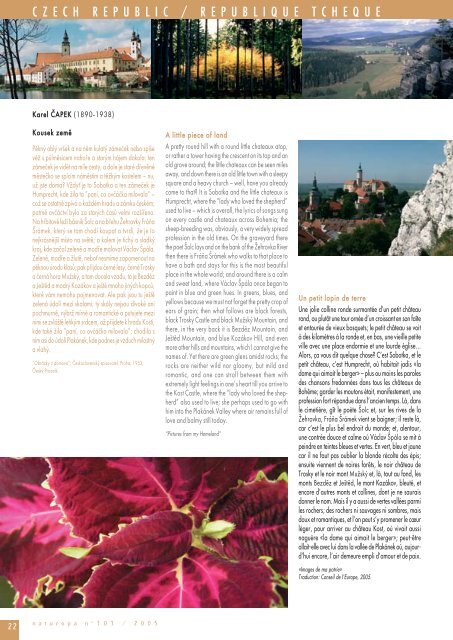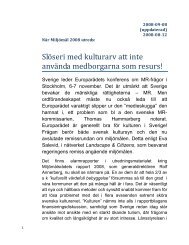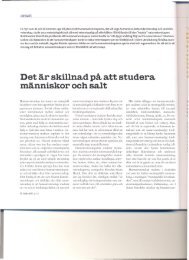Landscape through literature Le paysage à travers la littérature
Landscape through literature Le paysage à travers la littérature
Landscape through literature Le paysage à travers la littérature
Create successful ePaper yourself
Turn your PDF publications into a flip-book with our unique Google optimized e-Paper software.
22<br />
C Z E C H R E P U B L I C / R E P U B L I Q U E T C H E Q U E<br />
Karel ČAPEK (1890-1938)<br />
Kousek země<br />
Pěkný oblý vršek a na něm ku<strong>la</strong>tý zámeček nebo spíše<br />
věž s půlměsícem nahoře a starým hájem doko<strong>la</strong>; ten<br />
zámeček je vidět na míle cesty, a dole je staré dřevěné<br />
městečko se spícím náměstím a těžkým kostelem – nu,<br />
už jste doma? Vždyť je to Sobotka a ten zámeček je<br />
Humprecht, kde ži<strong>la</strong> ta “paní, co ovčáčka milova<strong>la</strong>“ –<br />
což se ostatně zpívá o každém hradu a zámku českém;<br />
patrně ovčáctví bylo za starých časů velmi rozšířeno.<br />
Na hřbitově leží básník Šolc a na břehu Žehrovky Fráňa<br />
Šrámek, který se tam chodí koupat a tvrdí, že je to<br />
nejkrásnější místo na světě; a kolem je tichý a s<strong>la</strong>dký<br />
kraj, kde začal zeleně a modře malovat Vác<strong>la</strong>v Špá<strong>la</strong>.<br />
Zeleně, modře a žlutě, neboť nesmíme zapomenout na<br />
pěknou úrodu k<strong>la</strong>sů; pak přijdou černé lesy, černé Trosky<br />
a černá hora Mužský, a tam doce<strong>la</strong> vzadu, to je Bezděz<br />
a Ještěd a modrý Kozákov a ještě mnoho jiných kopců,<br />
které vám nemohu pojmenovat. Ale pak jsou tu ještě<br />
zelená údolí mezi ska<strong>la</strong>mi; ty skály nejsou divoké ani<br />
pochmurné, nýbrž mírné a romantické a putujete mezi<br />
nimi se zvláště lehkým srdcem, až přijdete k hradu Kosti,<br />
kde také ži<strong>la</strong> “paní, co ovčáčka milova<strong>la</strong>”; chodi<strong>la</strong> s<br />
ním asi do údolí P<strong>la</strong>kánek, kde podnes je vzduch milostný<br />
a v<strong>la</strong>hý.<br />
“Obrázky z domova”, Československý spisovatel, Praha, 1953,<br />
Őeský Prozaik.<br />
n a t u r o p a n o 1 0 3 / 2 0 0 5<br />
A little piece of <strong>la</strong>nd<br />
A pretty round hill with a round little chateaux atop,<br />
or rather a tower having the crescent on its top and an<br />
old grove around; the little chateaux can be seen miles<br />
away, and down there is an old little town with a sleepy<br />
square and a heavy church – well, have you already<br />
come to that? It is Sobotka and the little chateaux is<br />
Humprecht, where the “<strong>la</strong>dy who loved the shepherd”<br />
used to live – which is overall, the lyrics of songs sung<br />
on every castle and chateaux across Bohemia; the<br />
sheep-breeding was, obviously, a very widely spread<br />
profession in the old times. On the graveyard there<br />
the poet Šolc <strong>la</strong>ys and on the bank of the Žehrovka River<br />
then there is Fráňa Šrámek who walks to that p<strong>la</strong>ce to<br />
have a bath and stays for this is the most beautiful<br />
p<strong>la</strong>ce in the whole world; and around there is a calm<br />
and sweet <strong>la</strong>nd, where Vác<strong>la</strong>v Špá<strong>la</strong> once began to<br />
paint in blue and green hues. In greens, blues, and<br />
yellows because we must not forget the pretty crop of<br />
ears of grain; then what follows are b<strong>la</strong>ck forests,<br />
b<strong>la</strong>ck Trosky Castle and b<strong>la</strong>ck Mužský Mountain, and<br />
there, in the very back it is Bezděz Mountain, and<br />
Ještěd Mountain, and blue Kozákov Hill, and even<br />
more other hills and mountains, which I cannot give the<br />
names of. Yet there are green glens amidst rocks; the<br />
rocks are neither wild nor gloomy, but mild and<br />
romantic, and one can stroll between them with<br />
extremely light feelings in one’s heart till you arrive to<br />
the Kost Castle, where the “<strong>la</strong>dy who loved the shepherd”<br />
also used to live; she perhaps used to go with<br />
him into the P<strong>la</strong>kánek Valley where air remains full of<br />
love and balmy still today.<br />
“Pictures from my Home<strong>la</strong>nd”<br />
Un petit lopin de terre<br />
Une jolie colline ronde surmontée d’un petit château<br />
rond, ou plutôt une tour ornée d’un croissant en son faîte<br />
et entourée de vieux bosquets; le petit château se voit<br />
<strong>à</strong> des kilomètres <strong>à</strong> <strong>la</strong> ronde et, en bas, une vieille petite<br />
ville avec une p<strong>la</strong>ce endormie et une lourde église…<br />
Alors, ça vous dit quelque chose? C’est Sobotka, et le<br />
petit château, c’est Humprecht, où habitait jadis «<strong>la</strong><br />
dame qui aimait le berger» – plus ou moins les paroles<br />
des chansons fredonnées dans tous les châteaux de<br />
Bohême; garder les moutons était, manifestement, une<br />
profession fort répandue dans l’ancien temps. L<strong>à</strong>, dans<br />
le cimetière, gît le poète Šolc et, sur les rives de <strong>la</strong><br />
Žehrovka, Fráňa Šrámek vient se baigner; il reste l<strong>à</strong>,<br />
car c’est le plus bel endroit du monde; et, alentour,<br />
une contrée douce et calme où Vác<strong>la</strong>v Špá<strong>la</strong> se mit <strong>à</strong><br />
peindre en teintes bleues et vertes. En vert, bleu et jaune<br />
car il ne faut pas oublier <strong>la</strong> blonde récolte des épis;<br />
ensuite viennent de noires forêts, le noir château de<br />
Trosky et le noir mont Mužský et, l<strong>à</strong>, tout au fond, les<br />
monts Bezděz et Ještěd, le mont Kozákov, bleuté, et<br />
encore d’autres monts et collines, dont je ne saurais<br />
donner le nom. Mais il y a aussi de vertes vallées parmi<br />
les rochers; des rochers ni sauvages ni sombres, mais<br />
doux et romantiques, et l’on peut s’y promener le cœur<br />
léger, pour arriver au château Kost, où vivait aussi<br />
naguère «<strong>la</strong> dame qui aimait le berger»; peut-être<br />
al<strong>la</strong>it-elle avec lui dans <strong>la</strong> vallée de P<strong>la</strong>kánek où, aujourd’hui<br />
encore, l’air demeure empli d’amour et de paix.<br />
«Images de ma patrie»<br />
Traduction: Conseil de l’Europe, 2005.





